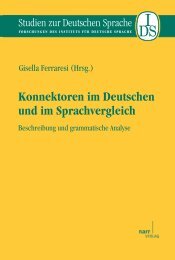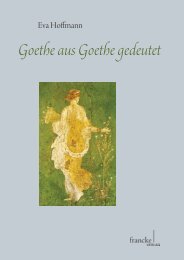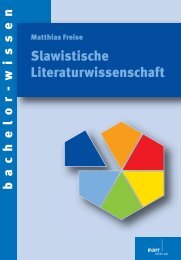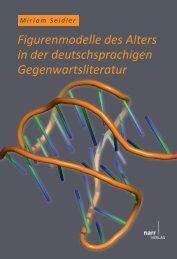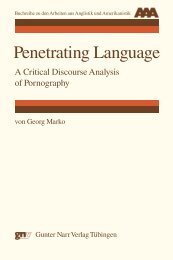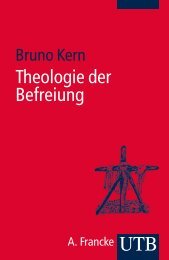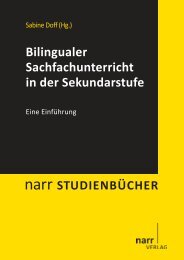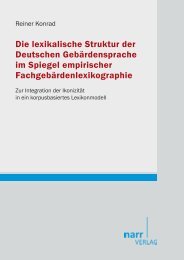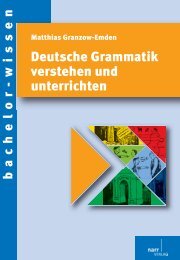Phraseologie. global - areal - regional - im Shop von Narr Francke ...
Phraseologie. global - areal - regional - im Shop von Narr Francke ...
Phraseologie. global - areal - regional - im Shop von Narr Francke ...
You also want an ePaper? Increase the reach of your titles
YUMPU automatically turns print PDFs into web optimized ePapers that Google loves.
Jarmo Korhonen/Wolfgang Mieder<br />
Elisabeth Piirainen/Rosa Piñel (Hg.)<br />
<strong>Phraseologie</strong><br />
<strong>global</strong> – <strong>areal</strong> – <strong>regional</strong><br />
Akten der Konferenz EUROPHRAS 2008<br />
vom 13.–16.8.2008 in Helsinki
<strong>Phraseologie</strong><br />
<strong>global</strong> – <strong>areal</strong> – <strong>regional</strong>
Jarmo Korhonen/Wolfgang Mieder<br />
Elisabeth Piirainen/Rosa Piñel (Hg.)<br />
<strong>Phraseologie</strong><br />
<strong>global</strong> – <strong>areal</strong> – <strong>regional</strong><br />
Akten der Konferenz EUROPHRAS 2008<br />
vom 13.–16.8.2008 in Helsinki
Bibliografische Information der Deutschen Nationalbibliothek<br />
Die Deutsche Nationalbibliothek verzeichnet diese Publikation in der<br />
Deutschen Nationalbibliografie; detaillierte bibliografische Daten sind <strong>im</strong> Internet über<br />
http://dnb.d-nb.de abrufbar.<br />
Gedruckt mit Unterstützung der Europäischen Gesellschaft für <strong>Phraseologie</strong><br />
und des Germanistischen Instituts der Universität Helsinki.<br />
© 2010 · <strong>Narr</strong> <strong>Francke</strong> Attempto Verlag GmbH + Co. KG<br />
Dischingerweg 5 · D-72070 Tübingen<br />
Das Werk einschließlich aller seiner Teile ist urheberrechtlich geschützt.<br />
Jede Verwertung außerhalb der engen Grenzen des Urheberrechtsgesetzes ist ohne<br />
Zust<strong>im</strong>mung des Verlages unzulässig und strafbar. Das gilt insbesondere für<br />
Vervielfältigungen, Übersetzungen, Mikroverfilmungen und die Einspeicherung und<br />
Verarbeitung in elektronischen Systemen.<br />
Gedruckt auf säurefreiem und alterungsbeständigem Werkdruckpapier.<br />
Internet: http://www.narr.de<br />
E-Mail: info@narr.de<br />
Druck und Bindung: Ilmprint, Langewiesen<br />
Printed in Germany<br />
ISBN 978-3-8233-6508-2
Inhaltsverzeichnis<br />
Vorwort ........................................................................................................................................... 9<br />
Foreword ...................................................................................................................................... 11<br />
I. <strong>Phraseologie</strong> <strong>global</strong> – <strong>areal</strong> – <strong>regional</strong><br />
Elisabeth Piirainen<br />
Common features in the phraseology of European languages:<br />
Cultural and <strong>areal</strong> perspectives ..................................................................................................... 15<br />
Antonio Pamies-Bertrán<br />
National linguo-cultural specificity vs. Linguistic <strong>global</strong>ization:<br />
The case of figurative meaning ..................................................................................................... 29<br />
Wolfgang Mieder<br />
“Many roads lead to <strong>global</strong>ization”. The translation and distribution of<br />
Anglo-American proverbs in Europe ............................................................................................ 43<br />
Wolfgang Eismann<br />
Remarks on Russian phrasemes in European languages ............................................................... 61<br />
Harald Burger/Peter Zürrer<br />
Französische und italienische Einflüsse auf die deutsche <strong>Phraseologie</strong> –<br />
Wann es sie gab und ob es sie heute noch gibt ............................................................................. 73<br />
Csaba Földes<br />
Auswirkungen des Deutschen auf die <strong>Phraseologie</strong> seiner östlichen Nachbarsprachen ............... 91<br />
Kari Keinästö<br />
Arme Ritter zwischen Baum und Borke? Phraseologismen deutscher Herkunft<br />
<strong>im</strong> hohen Norden ........................................................................................................................ 109<br />
Gyula Paczolay<br />
Some examples of <strong>global</strong>, <strong>regional</strong> and local proverbs in Europe and in the Far East ............... 121<br />
Bettina Bock<br />
Kann man indogermanische Phraseologismen systematisch rekonstruieren? ............................ 129<br />
Liudmila Diadechko<br />
Winged words as a nation consolidating factor .......................................................................... 137<br />
Natalia Filatkina<br />
Historical phraseology of German: Regional and <strong>global</strong> ............................................................ 143
6<br />
Inhaltsverzeichnis<br />
Željka Matulina/Zrinka orali<br />
Das Fremde <strong>im</strong> Eigenen. Integrierung <strong>von</strong> Topoi fremder Herkunft<br />
in eigensprachige Kontexte ......................................................................................................... 153<br />
Sabine Fiedler<br />
„Am Ende des Tages zählt die Performance.“ – Der Einfluss des Englischen<br />
auf die <strong>Phraseologie</strong> der deutschen Gegenwartssprache ............................................................. 163<br />
Anita Pavi Pintari<br />
Das deutsche Element in der kroatischen <strong>Phraseologie</strong> .............................................................. 173<br />
Mudite Smiltena<br />
Lettische Idiome <strong>im</strong> Rahmen des Projekts „Weit verbreitete Idiome<br />
in Europa und darüber hinaus“ ................................................................................................... 179<br />
Günter Schmale<br />
nun di Die isch han de Flämm – Französische Einflüsse auf phraseologische<br />
Ausdrücke des Rheinfränkischen ................................................................................................ 185<br />
Bernhard Brehmer<br />
Komparative Phraseologismen in den slavischen Sprachen: Vorüberlegungen<br />
zu einer <strong>areal</strong>linguistischen Betrachtung .................................................................................... 195<br />
Ane Kleine<br />
Jiddische <strong>Phraseologie</strong> – <strong>Phraseologie</strong> einer Fusionssprache ..................................................... 205<br />
Matthias Funk<br />
Kurz- und langfristige Tendenzen in der Sprichwortentwicklung .............................................. 213<br />
Anna Idström<br />
Challenges of documenting the idioms of an endangered language:<br />
The case of Inari Saami .............................................................................................................. 221<br />
Annette Sabban<br />
Für ’n Appel und ’n Ei: Phraseme mit sprechsprachlichen und dialektalen<br />
Komponenten und ihre Verwendung <strong>im</strong> Text ............................................................................. 229<br />
II. <strong>Phraseologie</strong> kontrastiv bzw. vergleichend<br />
Viktoria Umborg<br />
Deutsche feste Wortverbindungen in Fachtexten <strong>im</strong> Vergleich mit ihren<br />
estnischen und russischen Entsprechungen ................................................................................ 239<br />
Dmitrij Dobrovol’skij/Tatjana V. Filipenko/Artëm V. Šarandin<br />
<strong>Phraseologie</strong> <strong>im</strong> „Neuen Deutsch-Russischen Großwörterbuch“ ............................................... 247<br />
Peter uro<br />
WICOL – Deutsch-Slowakisches Kollokationswörterbuch ........................................................ 255<br />
Iva Fidancheva<br />
Malediktische Euphemismen – Die verletzende Macht der Höflichkeit ..................................... 261
Berit Balzer/Rosa Piñel<br />
Vorschlag eines klassifikatorischen Modells für Routineformeln<br />
psycho-sozialer Art ..................................................................................................................... 269<br />
Carmen Mellado Blanco<br />
Die phraseologische Äquivalenz auf der System- und Textebene<br />
(am Beispiel des Sprachenpaares Deutsch-Spanisch) ................................................................. 277<br />
Encarnación Tabares Plasencia<br />
Ausgewählte Übersetzungsprobleme der juristischen Fachphraseologie.<br />
Vergleich Deutsch-Spanisch ....................................................................................................... 285<br />
Heike van Lawick<br />
Phraseologismen in der Minderheitensprache Katalanisch: Global, <strong>areal</strong> oder dialektal?<br />
Eine korpuslinguistisch gestützte Untersuchung <strong>von</strong> Übersetzungen ........................................ 293<br />
Ayfer Akta<br />
Eine kontrastive Darstellung der deutschen und türkischen Geld-Phraseologismen .................. 301<br />
František ermák<br />
Binomials: Their nature in Czech and in general ........................................................................ 309<br />
Joanna Szerszunowicz<br />
On cultural connotations of idioms expressing language users’ collective memory<br />
in a comparative perspective. A case study: gest Kozakiewicza ................................................. 317<br />
Maria Celeste Augusto<br />
Phraséologies de l’œil en portugais et en néerlandais dans un cadre<br />
lexico-sémantique – une approche contrastive ........................................................................... 325<br />
Maria Husarciuc/Anca-Diana Bibiri<br />
Phraseological units between national specificity and universality. Contrastive<br />
approach applied to French and Romanian languages ................................................................ 333<br />
Antonio Pamies-Bertrán et al.<br />
Implementación lexicográfica de los símbolos desde un enfoque<br />
multilingüe trans-cultural ............................................................................................................ 339<br />
Elena Berthemet<br />
“Phraseological Equivalence” in digital multilingual dictionaries ............................................. 351<br />
Juan de Dios Luque Durán/Lucía Luque Nadal<br />
Cómo las metáforas recurren a conoc<strong>im</strong>ientos ontológicos y culturales.<br />
Fundamentos teóricos del Diccionario Intercultural e Interlingüístico ....................................... 359<br />
Stefan Hauser<br />
Von Sündern, Sümpfen und Seuchen – Reflexionen zum Konzept „Sprache als<br />
kulturelles Gedächtnis“ am Beispiel des Dopingdiskurses ......................................................... 367<br />
7
8<br />
Inhaltsverzeichnis<br />
Melanija Larisa Fab<br />
Pop-kulturelle Aspekte der phraseologischen Kompetenz: Die text- und<br />
(denk)stilbildenden Potenzen phraseologischer Einheiten in deutschen<br />
und slowenischen Hiphop-Texten ............................................................................................... 375<br />
Sabine Mohr-Elfadl<br />
Zum phraseologischen Ausdruck <strong>von</strong> Temporalität <strong>im</strong> deutsch-<br />
französischen Vergleich .............................................................................................................. 381<br />
Tamás Forgács<br />
Phraseologische Einheiten <strong>im</strong> Spiegel der lexikalischen Bedeutung .......................................... 389<br />
Nihada Delibegovi Džani/Sanja Berberovi<br />
Conceptual integration theory and metonymy in idiom modifications ....................................... 397<br />
Stephan Stein<br />
Mündlichkeit und Schriftlichkeit, phraseologisch gesehen ........................................................ 409
Vorwort<br />
Das Germanistische Institut der Universität Helsinki und die Europäische Gesellschaft für <strong>Phraseologie</strong><br />
veranstalteten mit Unterstützung des Finnischen DAAD-Vereins vom 13. bis 16. August<br />
2008 in Helsinki eine internationale Konferenz mit dem Rahmenthema „<strong>Phraseologie</strong> <strong>global</strong> –<br />
<strong>areal</strong> – <strong>regional</strong>“ (= EUROPHRAS 2008). Die Konferenz, an der über 200 Personen aus 34 Ländern<br />
teilnahmen, setzte sich aus zwei Teilen zusammen: 1. aus einem Symposium zum Thema<br />
„Languages and Cultures under the Pressure of Globalization: Phraseology – a Burden or a<br />
Benefit?“ und 2. aus EUROPHRAS-Sektionen und dem Workshop „Collocations in Specialized<br />
Discourses“. Das Programm des Symposiums, das einen Teil der Feierlichkeiten zum 100-jährigen<br />
Bestehen der Finnischen Akademie der Wissenschaften bildete, bestand aus sieben Vorträgen,<br />
in denen die Beeinflussung der <strong>Phraseologie</strong> best<strong>im</strong>mter Sprachen durch andere Sprachen thematisiert<br />
wurde. Neben Referaten zum Rahmenthema der Konferenz wurden anschließend in sieben<br />
parallelen Sektionen solche zu Ursprung, Entwicklung, Struktur und Gebrauch <strong>von</strong> Phraseologismen<br />
sowohl in einzelnen Sprachen als auch kontrastiv bzw. vergleichend zwischen mehreren<br />
Sprachen gehalten. Die Zahl der Referate in den Sektionen und <strong>im</strong> Workshop belief sich insgesamt<br />
auf 162 (zum Verlauf der Konferenz vgl. auch die beiden Berichte <strong>von</strong> Annikki Li<strong>im</strong>atainen/Ulrike<br />
Richter-Vapaatalo in: http://www.europhras.org/bulletin/Europhras_Bulletin_Gesamt_2009.pdf,<br />
S. 7-11 bzw. <strong>von</strong> Antje Heine u. a. in: Neuphilologische Mitteilungen 110, S.<br />
255-263).<br />
Da die Veröffentlichung aller bei EUROPHRAS 2008 gehaltenen Vorträge schon aus finanziellen<br />
Gründen nicht in Frage kommt, haben die Organisatoren folgende Entscheidung getroffen:<br />
Eine Auswahl der Vorträge, die sich direkt auf das Rahmenthema beziehen oder kontrastiv bzw.<br />
vergleichend zwischen verschiedenen Sprachen oder Sprachvarietäten angelegt sind, wird in einen<br />
Sammelband aufgenommen, für weitere Vorträge ist die Veröffentlichung <strong>im</strong> Internet vorgesehen.<br />
Darüber hinaus haben sich nach der Konferenz einige Kollegen bereit erklärt, jeweils eigene<br />
Sammelbände herauszugeben, und zwar neben dem Workshop zu folgenden Teilbereichen: Routineformeln,<br />
<strong>Phraseologie</strong> in literarischen Texten und computergestützte <strong>Phraseologie</strong>. Insgesamt<br />
wurden den Organisatoren 98 Beiträge für die Veröffentlichung angeboten.<br />
Auf der Basis einer Begutachtung und gemeinsamen Beratung durch die Herausgeber wurden<br />
in den vorliegenden Sammelband 43 Beiträge aufgenommen. Die Auswahl der Beiträge gründet<br />
sich auf inhaltliche und qualitative Kriterien, wobei zusätzlich darauf geachtet wurde, dass möglichst<br />
viele Sprachfamilien (germanisch, slawisch, romanisch usw.) vertreten sind. Der Band besteht<br />
aus zwei Blöcken: I. <strong>Phraseologie</strong> <strong>global</strong> – <strong>areal</strong> – <strong>regional</strong> und II. <strong>Phraseologie</strong> kontrastiv<br />
bzw. vergleichend. An den Anfang des ersten Blocks wurden die sieben Symposiumsvorträge<br />
gestellt. Ihnen folgen zunächst Beiträge, in denen die <strong>Phraseologie</strong> unter <strong>global</strong>em Gesichtspunkt<br />
betrachtet wird; dabei kann der <strong>global</strong>e Aspekt durch <strong>areal</strong>e und/oder <strong>regional</strong>e Aspekte ergänzt<br />
sein. Danach kommen Beiträge, in denen die Globalisierung als Entlehnung <strong>von</strong> Phraseologismen<br />
aus einer Sprache in eine andere verstanden wird. Am Ende <strong>von</strong> Block I. stehen Beiträge, in denen<br />
<strong>areal</strong>e oder <strong>regional</strong>e Aspekte der <strong>Phraseologie</strong> <strong>im</strong> Vordergrund stehen. Der zweite Block<br />
wiederum wird durch kontrastive Beiträge eingeleitet. Als erster erscheint ein Beitrag mit drei<br />
Sprachen, in den folgenden Beiträgen werden jeweils zwei Sprachen einander gegenübergestellt.<br />
Maßgeblich für die Anordnung der Beiträge mit zwei Sprachen war die Zugehörigkeit der unter-
10<br />
Vorwort<br />
suchten Sprachen zu best<strong>im</strong>mten Sprachfamilien. In den meisten Beiträgen wird eine germanische<br />
Sprache (vor allem das Deutsche) mit einer slawischen oder romanischen Sprache kontrastiv beschrieben,<br />
weshalb ihnen der Vorrang gegeben wurde. Der Aufbau des zweiten Teils <strong>von</strong> Block<br />
II., d. h. der Komplex der vergleichenden Beiträge, ist dem des ersten Teils ähnlich. Am Anfang<br />
stehen Beiträge mit mehreren Sprachen, gefolgt <strong>von</strong> Beiträgen mit zwei Sprachen. Auch in den<br />
letztgenannten Beiträgen steht die deutsche Sprache an zentraler Stelle.<br />
Die Durchführung der Konferenz EUROPHRAS 2008 wurde durch finanzielle Unterstützung<br />
<strong>von</strong> acht Institutionen und eine großzügige Spende <strong>von</strong> Prof. Dr. Wolfgang Mieder ermöglicht.<br />
Die Institutionen waren: Finnische Akademie der Wissenschaften, Verband der wissenschaftlichen<br />
Gesellschaften Finnlands, Emil Öhmann-Stiftung, Deutscher Akademischer Austauschdienst,<br />
Europäische Gesellschaft für <strong>Phraseologie</strong>, Universität Helsinki, Germanistisches Institut<br />
der Universität Helsinki und Neuphilologischer Verein in Helsinki. Allen Sponsoren möchte ich<br />
auch an dieser Stelle einen herzlichen Dank aussprechen, ebenso danke ich der Europäischen<br />
Gesellschaft für <strong>Phraseologie</strong> und dem Germanistischen Institut der Universität Helsinki für die<br />
Bewilligung der Zuschüsse, die für die Drucklegung des Bandes erforderlich waren. Den übrigen<br />
Mitgliedern des Organisationsausschusses (Prof. Dr. Irma Hyvärinen, Dr. Antje Heine, Dr. Ulrike<br />
Richter-Vapaatalo, Petra Schirrmann-Krapinoja, Nadia Gondolph und Jouni Heikkinen) sowie<br />
allen Mitarbeitern und Studierenden, die bei der Vorbereitung und Organisierung der Konferenz<br />
geholfen haben, bin ich sehr dankbar. Petra Schirrmann-Krapinoja und Nadia Gondolph schulde<br />
ich außerdem großen Dank für die Hilfe, die ich <strong>von</strong> ihnen für die Bearbeitung und äußere Vereinheitlichung<br />
der Beiträge sowie für die Erstellung der Druckvorlage erhalten habe. Desgleichen<br />
gebührt Kai Kuosmanen ein Dankeschön für die Lösung mancher EDV-Probleme. Schließlich<br />
danke ich dem Gunter <strong>Narr</strong> Verlag für die gute Zusammenarbeit und meinen Mitherausgebern<br />
Wolfgang Mieder, Elisabeth Piirainen und Rosa Piñel für ihren engagierten Einsatz bei der inhaltlichen<br />
und sprachlichen Bearbeitung der Beiträge.<br />
Helsinki, <strong>im</strong> Oktober 2009 Jarmo Korhonen
Foreword<br />
The German Department of the University of Helsinki and the European Society of Phraseology,<br />
supported by the Finnish DAAD Alumni Club, hosted an international conference in Helsinki on<br />
August 13-16, 2008. The topic was “Phraseology <strong>global</strong> – <strong>areal</strong> – <strong>regional</strong>” (= EUROPHRAS<br />
2008). Over 200 people from 34 countries participated in the two-part conference. Part 1 was a<br />
symposium on the topic “Languages and Cultures under the Pressure of Globalization: Phraseology<br />
– a Burden or a Benefit?” Part 2 consisted of EUROPHRAS sections and a workshop entitled<br />
“Collocations in Specialized Discourses”. The symposium program, part of the festivities celebrating<br />
the 100 th anniversary of the Finnish Academy of Science and Letters, consisted of seven<br />
lectures on the central theme of how the phraseology of certain languages influences others. Following<br />
these lectures there were seven s<strong>im</strong>ultaneous sections about the origin, development,<br />
structure and use of phraseologisms within individual languages as well as comparisons and contrasts<br />
of multiple languages. In total there were 162 presentations in the sections and workshop<br />
(for further information about the conference as such please see the two reports by Annikki Li<strong>im</strong>atainen/Ulrike<br />
Richter-Vapaatalo at: http://www.europhras.org/bulletin/Europhras_Bulletin_Gesamt_2009.pdf,<br />
pp. 7-11 and by Antje Heine et al. in: Neuphilologische Mitteilungen 110, pp.<br />
255-263).<br />
As the publication of all presentations from the EUROPHRAS 2008 is not possible pr<strong>im</strong>arily<br />
due to financial reasons, the organizers came to the following decision: A selection of presentations<br />
which are directly related to the central theme or show a contrast or comparison between<br />
various languages or language varieties will be included in an essay volume. Additional presentations<br />
will be published on the internet. Furthermore, after the conference several colleagues<br />
agreed to edit their own essay volumes in addition to the workshop in the following areas: routine<br />
formulas, phraseology in literary texts and computer-supported phraseology. A total of 98 contributions<br />
were submitted to the organizers for publication.<br />
After an appraisal and consultation among the editors, 43 articles were accepted for this essay<br />
volume. The selection of articles was based on contextual and qualitative criteria as well as the<br />
inclusion of as many language families as possible (Germanic, Slavic, Romance, etc.). The essay<br />
volume consists of two parts: I. Phraseology <strong>global</strong> – <strong>areal</strong> – <strong>regional</strong> and II. Contrastive and<br />
comparative phraseology. At the beginning of the first part are the seven symposium lectures.<br />
Following these are articles in which phraseology is examined from a <strong>global</strong> viewpoint, with the<br />
<strong>global</strong> aspect at t<strong>im</strong>es being supplemented by <strong>areal</strong> and/or <strong>regional</strong> aspects. Next are articles in<br />
which <strong>global</strong>ization is understood as one language borrowing phraseologisms from another. At<br />
the end of part I are articles focusing on <strong>areal</strong> or <strong>regional</strong> aspects of phraseology. Part II opens<br />
with contrastive articles. First is an article contrasting three languages, the following articles all<br />
contrast two languages. The order of articles dealing with two languages was based on membership<br />
of the examined languages to specific language families. In most articles a Germanic language<br />
(pr<strong>im</strong>arily German) is contrasted with a Slavic or Romance language, which is the reason<br />
they were given precedence. The arrangement of the second section of part II, i. e. the group of<br />
comparative articles, is s<strong>im</strong>ilar to the first section. At the beginning there are articles dealing with<br />
multiple languages, followed by articles about two languages. Again the German language has a<br />
central role in these articles.
12<br />
Foreword<br />
The EUROPHRAS 2008 conference was made possible through financial support from eight<br />
institutions and a generous donation from Prof. Dr. Wolfgang Mieder. The institutions are: Finnish<br />
Academy of Science and Letters, Federation of Finnish Learned Societies, Emil Öhmann<br />
Foundation, German Academic Exchange Service, European Society of Phraseology, University<br />
of Helsinki, German Department of the University of Helsinki and Modern Language Society in<br />
Helsinki. I would like to express my heartfelt thanks again to all sponsors as well as special<br />
thanks to the European Society of Phraseology and the German Department of the University of<br />
Helsinki for approving the grant for the printing of the essay volume. I am also very grateful to<br />
the other members of the organization committee (Prof. Dr. Irma Hyvärinen, Dr. Antje Heine, Dr.<br />
Ulrike Richter-Vapaatalo, Petra Schirrmann-Krapinoja, Nadia Gondolph and Jouni Heikkinen)<br />
and to all employees and students who helped in the preparation and organization of the conference.<br />
I would like to express a special thank you to Petra Schirrmann-Krapinoja and Nadia Gondolph<br />
for their help with the editing and standardization of the articles as well as with the preparation<br />
of the printer’s copy. Thank you also to Kai Kuosmanen for solving computer problems. And<br />
finally I would like to thank the Gunter <strong>Narr</strong> Publishing House for the good collaboration and my<br />
co-editors Wolfgang Mieder, Elisabeth Piirainen and Rosa Piñel for their dedicated work with the<br />
content and language of the articles.<br />
Helsinki, October 2009 Jarmo Korhonen
I. <strong>Phraseologie</strong> <strong>global</strong> – <strong>areal</strong> – <strong>regional</strong>
Elisabeth Piirainen (Steinfurt)<br />
Common features in the phraseology of European<br />
languages: Cultural and <strong>areal</strong> perspectives<br />
1 Introduction to the problems<br />
The linguistic discipline of phraseological research looks back at a more than one hundred year<br />
old tradition. The studies on phraseology carried out by Charles Bally (1905; 1909), especially his<br />
influential classification of fixed expressions in the context of his “stylistique”, are usually regarded<br />
as the beginning of modern linguistic research into phraseology. Indeed it was Charles<br />
Bally who pointed out extensive cross-linguistic s<strong>im</strong>ilarities between the languages of Europe that<br />
were even more striking than their differences – a fact he tried to link to a “European mentality”:<br />
Même pour un observateur superficiel, les langues modernes des pays dits « civilisés » offrent des ressemblances<br />
en nombre incalculable, et dans leur incessante évolution, ces langues, loin de se différencier,<br />
tendent à se rapprocher toujours davantage. La cause de ces rapprochements n’est pas difficile à<br />
trouver; elle réside dans les échanges multiples qui se produisent de peuple à peuple, dans le monde matériel<br />
et dans le domaine de la pensée. […] Appelons ce fonds commun, faute de mieux, la mentalité européenne.<br />
(Bally 1909, 22f.)<br />
Whether Bally also had phraseology in mind here, and which modern languages exactly he was<br />
referring to, is not explicitly clear from his remarks. It should be noted, however, how even more<br />
than one hundred years ago there was an awareness of the far-reaching s<strong>im</strong>ilarities between the<br />
languages of Europe. Still to this day, and despite the vast amount of work on idioms, almost<br />
nothing is known about the actual s<strong>im</strong>ilarities that exist between idioms in the European languages.<br />
1 Neither the numerous studies on idioms of various individual languages nor the equally<br />
comprehensive work on contrastive comparisons of the idioms of two or more languages have so<br />
far been able to change this. They have not been able to name the actual idioms that have equivalents<br />
in many European languages and thus describe what idioms can be counted among the “core<br />
inventory” of a common European phraseology.<br />
Further questions that remain unanswered until today include: Which languages take part in<br />
the phraseological correspondences? Are there <strong>areal</strong> centers within Europe? Can differences be<br />
detected between the literary languages und the less established minor languages of Europe? Of<br />
particular interest would be, ult<strong>im</strong>ately, the causes of those s<strong>im</strong>ilarities, i. e. the historical, geographical,<br />
social and cultural factors that are responsible for the dissemination of certain idioms in<br />
many languages inside and outside of Europe.<br />
Solutions to this type of problems cannot be hoped to be tackled by individual people, but only<br />
through collaboration of a large group of researchers and by bundling research initiatives within a<br />
long-term perspective. The fact is, however, that phraseological research even today is more likely<br />
to be undertaken by individuals than in larger teams. At the same t<strong>im</strong>e, researchers often work<br />
on the same problems, even on almost identical phraseological material, without mutual awareness<br />
of their colleagues’ work. Furthermore, researchers tend to group Europe into small units of<br />
1 Unlike idiom research, proverb studies were practised on a multilanguage scale from the beginning, cf. Paczolay’s<br />
(1997) studies on the European proverbs. There is no tradition of Europe-wide idiom studies that would be comparable<br />
to the prosperous international cooperation in the field of proverb research, a gap that was not even recognised until<br />
recently.
16<br />
Elisabeth Piirainen<br />
two or three languages per unit that are separated from other languages by clear boundaries, without<br />
regard to the whole. This can be illustrated with a very recent example, cited here only as one<br />
example of many s<strong>im</strong>ilar studies.<br />
In a conference volume that was recently published (Álvarez de la Granja 2008), there are 19<br />
contributions from the field of cross-linguistic, mainly bilingual, phraseology. There are several<br />
cases where one and the same idiom is discussed in different articles of the book, without reference<br />
to one another. For example, an article on Latvian and French proverbs (Billere 2008, 256)<br />
finds that both languages reveal the same attitude towards a man’s work: “Quand il s’agit de<br />
l’attitude des gens envers le travail, les français aussi bien que les lettons associent le travail au<br />
pain”, citing the French idiom manger son pain à la sueur de son front “to eat one’s bread by the<br />
sweat of one’s forehead”. The biblical origin of the idiom (Genesis 3:19) or the linguistic situation<br />
in languages other than Latvian and French, however, play no role.<br />
The same idiom is the topic of a trilingual study in the above-mentioned volume (Ayupova<br />
2008, 51), which observes that “[w]hen a Russian works very hard his face sweats ( –<br />
with sweat in one’s face), whereas sweat will on the Englishman’s brow (the sweat of one’s brow)<br />
and the Tatar’s forehead ( – with sweat on the forehead).” The author comes<br />
to the conclusion that “[s]uch differences in the componential structure of interlingual phraseological<br />
equivalents cannot be due to any other factor than people’s differing mentalities, linguistic<br />
<strong>im</strong>ages of the world, or the associations speakers of these languages make.” (ibid.) Again,<br />
instead of a consideration of the cultural and historical background – the fact that the lexical differences<br />
between face, brow and forehead are due to different biblical traditions, i. e. to different<br />
translations of one and the same verse from the Bible – unsound explanations are made based on<br />
“people’s differing mentalities”.<br />
Such examples show that phraseological research has to get away from accidental observations<br />
on “s<strong>im</strong>ilarities” or “differences” of idioms in a few languages and instead study the phenomena<br />
across as many languages as possible. Above all, phraseology is a linguistic level that – due to its<br />
interrelation with culture – can be better explored and understood in a pan-European context. An<br />
inventory of idioms that shows equivalents across many languages, be it in the form of a reference<br />
book or otherwise, is a matter of urgent necessity in order to provide researchers with information<br />
that goes beyond only a few languages.<br />
As only a large-scale investigation can reveal, more than 52 European languages have adopted<br />
equivalents of the idiom by the sweat of one’s brow (or German <strong>im</strong> Schweiße seines Angesichts<br />
“by the sweat of one’s face”, Spanish con el sudor de su frente “with the sweat of his forehead”,<br />
etc.). Map 1 illustrates the diffusion of the idiom: Languages marked on gray rectangles possess<br />
equivalents. Certain regularities can be discovered with respect to the different constituents: All<br />
Romance languages, as well as Albanian, Greek and North Finnic languages have the variant with<br />
forehead, all Germanic languages (except for English), the Baltic languages, Hungarian and Maltese<br />
have the variant face, while the Sla<strong>von</strong>ic languages vary between the two or use them side by<br />
side (e. g. Macedonian vo potta na svoeto lice/elo “in the sweat of his face/forehead”). The<br />
variant brow is restricted to English, Irish (as allas a mhalai/le hallas a mhalaí “by the sweat of<br />
his brow”) and West Kara<strong>im</strong>, a very small declining Turkic language (manlajynyn terinia kadar<br />
(išliamia) “(to work) till the sweat on one’s brow”). Other Turkic languages (Turkish, Tatar and<br />
Azerbaijani) follow the pattern forehead. A variant “with sweat on one’s cheek” is known in Latvian<br />
(ar sviedriem vaig). Map 1 is among the early results that emerged in the context of the<br />
project “Widespread Idioms in Europe and Beyond”, which will be briefly outlined below.
Common features in the phraseology of European languages: Cultural and <strong>areal</strong> perspectives 17<br />
Map 1: Equivalents of the idiom by the sweat of one’s brow/face/forehead in European languages 2<br />
2 Widespread idiom research: theoretical framework<br />
In the age of information, a comprehensive database that could include the totality of idioms of<br />
dozens of languages is no longer a utopia. Today’s technological possibilities allow the storage of<br />
enormous amounts of linguistic data, as well as easy retrieval for specific, precisely formulated<br />
questions. However, intensive groundwork, undertaken by a large group of linguists, would be required<br />
in order to encode the phraseological data accordingly and make them comparable to each<br />
other. If the most common idioms (those that are present in the speaker’s mental lexicon) of various<br />
European standard languages were registered in a database and made compatible with each<br />
other, it would be considerably easier to answer the questions regarding presumable common<br />
features of idioms of the European languages that were raised above. The project “Widespread<br />
Idioms in Europe and Beyond” should be regarded as one small step into this direction. 3<br />
One of the main goals of the project is to identify the core inventory of idioms that exist in<br />
many languages (Europe-wide and beyond), based on a systematic analysis of this phenomenon<br />
across all European languages accessible to idiom research. As the project to be introduced here<br />
breaks new ground in linguistics, we must first develop its theoretical foundation and a suitable<br />
2 The occurrence of the Yiddish idiom arbetn mitn shveys fun dem pon<strong>im</strong> cannot be depicted on the map.<br />
3 The project has been supported by the European Society of Phraseology from its beginning in 2004 and is now actively<br />
supported by the team of the Cultural Historical Research Centre established at the University of Trier (Dr. Natalia<br />
Filatkina and Dr. Ane Kleine; www.hkfz.uni-trier.de). However, all work on the widespread idiom project has<br />
been carried out based on the voluntary collaboration of more than 200 individuals.
18<br />
Elisabeth Piirainen<br />
metalanguage. As a working term, Widespread idiom (or WI for short), has been suggested. 4 Because<br />
this term is newly introduced to linguistics, we need to create a working definition. This<br />
definition must be based on criteria by which actual WIs in Europe and beyond can be singled out<br />
from other idioms that exist in some five, six or more languages. Therefore, the definition is initially<br />
based on heuristics, starting exclusively from the linguistic situation of Europe and the empirical<br />
multilingual phraseological data.<br />
As far as the linguistic situation of Europe is concerned, with its many genetically diverse languages<br />
between the Atlantic and the Ural mountain range, extra-linguistic factors are taken into<br />
account. In order to be considered “widespread”, idioms must occur in languages of the main<br />
geographic regions of Europe; this means that they are not only genetically distant but are also not<br />
neighboring geographically. By this criterion, idioms are excluded which may exist in several<br />
languages but whose circulation is restricted to only a small area (comparable to a “Sprachbund”<br />
where languages are in narrow contact with each other, be it through a diglossic situation, roofing<br />
languages or cross-border contacts). The definition will not require any particular min<strong>im</strong>um number<br />
of languages involved.<br />
Furthermore, the specific characteristics of the semantics of (prototypical) idioms are included<br />
in the definition. This refers to the interaction of the two semantic levels of an idiom: its inner<br />
form (the literal meaning) and its figurative or actual meaning. Firstly, idioms to be designated as<br />
WIs must have the same or a s<strong>im</strong>ilar lexical structure in various languages. Secondly, these idioms<br />
must have a s<strong>im</strong>ilar figurative meaning, 5 to be precise: they must share the same figurative<br />
core meaning.<br />
Such wide concepts of s<strong>im</strong>ilarity both at the level of literal readings and at the level of actual<br />
meanings leave room for an interpretation of each individual case within its historic-cultural development:<br />
We must take into account the characteristic feature of idioms as linguistic signs that<br />
are handed down historically and coined culturally. In the course of history, both the literal and<br />
the figurative meaning of an idiom of an individual language can be affected by individual developments<br />
that are unique to one language. If, therefore, lexical-semantic divergence is observed<br />
from a synchronic perspective, cultural foundations must be taken into account to clarify the question<br />
whether we are dealing with a WI or not. 6<br />
The definition is thus: Widespread idioms (WIs) are idioms that – when their particular cultural<br />
and historical development is taken into account – have the same or a s<strong>im</strong>ilar lexical structure<br />
and the same figurative core meaning in various different languages, including geographically<br />
and genetically distant languages.<br />
3 Ascertaining widespread idioms: methodological approach<br />
It is completely unpredictable which idioms are actually affected by a wide dissemination and<br />
which ones are not. There are some vague ideas that idioms originating in works of world literature,<br />
in the Bible or Greco-Roman classics, tend to exist in many languages, but nothing definite<br />
can be said which these idioms are in reality. The German phraseological lexicon, for example,<br />
has about 150 idioms of biblical origin (cf. Parad 2003), most of them being more or less wellknown<br />
and actively used by the speakers. However, no explication has been found, why “only” 43<br />
biblical idioms and further 12 idioms known both from the Bible and other texts are really spread<br />
4 Terms like Europeanism or internationalism are not appropriate for our objectives (cf. Piirainen 2008a, 244f.).<br />
5 By this criterion, cases are excluded where lexical structures that are identical s<strong>im</strong>ply by chance lead to diverging<br />
semantic results (so-called false friends).<br />
6 Therefore, the proper place of this research project is not in contrastive linguistics in the traditional sense. It cannot<br />
pr<strong>im</strong>arily be concerned with relationships of equivalence between idioms of different languages (e. g. with respect to<br />
all their diasystematic features or their syntactic, pragmatic, and/or textual behaviour).
Common features in the phraseology of European languages: Cultural and <strong>areal</strong> perspectives 19<br />
across many languages (see section 4 below). The same holds for modern source domains of idioms<br />
such as sports (e. g. racing, boxing, and athletics). It remains unclear why there are equivalents<br />
of the idioms a race against t<strong>im</strong>e, to be on the finishing straight or to hit below the belt in 40<br />
or more languages, while idioms such as to be off the starting blocks or to clear a hurdle can be<br />
found at best in a dozen of languages.<br />
In order to ascertain widespread idioms, extensive groundwork has been done, relying on the<br />
assistance of experts of many languages. The WI data have been collected as follows: First, a list<br />
of about 1.000 potential WIs was compiled based on some prel<strong>im</strong>inary knowledge and later completed<br />
by systematic and large-scale studies, checking many publications on phraseology and<br />
idiom dictionaries. The starting point was not only some major “school languages” of Central<br />
Europe, but also included Finnish, Greek and Russian. The idioms then have been pre-tested by<br />
experts of further geographically and genetically diverse languages (Hungarian, Estonian, Latvian,<br />
Polish, Croatian, Bulgarian, Spanish and Romanian). The result was a remaining core set of<br />
about 400 actual “widespread idiom candidates” which then had to be reviewed for as many languages<br />
as possible.<br />
For this purpose a network of competent collaborators has been built up and questionnaires<br />
with the “WI candidates” were sent via e-mail to many native speakers and linguists, covering<br />
more than 80 languages and asking addressees to answer the questions based on both their own<br />
competence and discussions within their circle of colleagues. The questionnaires were filled in<br />
carefully for the most part. Several participants have verified their information via text corpus<br />
analyses or investigations on the Internet. For several minor and minority languages, these resources<br />
did not exist, neither was it possible to refer to idiom dictionaries. In these cases the informants’<br />
answers were a particularly valuable and a unique source.<br />
4 Cultural foundations of widespread idioms<br />
At the t<strong>im</strong>e of this writing, the surveys have produced a total of 330 items that fulfill the criteria<br />
of widespread idioms. The main question of the cultural domains that the WIs belong to can now<br />
be answered more precisely. Idioms that are really widespread across the languages of Europe and<br />
beyond can be categorized according to their cultural foundations. For this purpose, the distinction<br />
between a synchronic and a diachronic (etymological) level of analysis can be left aside. This<br />
means that the set of widespread idioms can be structured, for the most part, according to the<br />
underlying etymological and cultural features. Quantitative aspects of the cultural foundations<br />
have also emerged. Five main parts can be distinguished and divided into 19 smaller groups, even<br />
though they tend to overlap and interrelate. We will give a short overview.<br />
Part I: Intertextuality<br />
The greatest part, with 173 items almost half of the entire inventory of WIs, is made up of idioms<br />
that belong to the cultural domain of intertextuality. Idioms of this kind have an already existing<br />
(mostly identifiable) text as their sources. 7 The inventory clearly shows which works of literature<br />
and which details of passages in a text have led to widespread idioms and which ones have not.<br />
The WIs discovered so far are distributed, in varying numbers, over seven groups of sources of<br />
text passages:<br />
7 It is beyond the scope of this article to go into the term intertextuality in detail. Phraseology researchers use it with<br />
different meanings. Burger (1991) applies it to the availability of pre-fabricated text fragments (aphorisms, slogans,<br />
book titles etc.) and their interweaving in a text, while paremiologists understand it in the sense of the interrelation between<br />
proverbs and narrative texts (cf. Carnes 1994). Intertextuality is even seen as a constituent element or definition<br />
criterion of the proverb (Bauman/Briggs 1990; Winick 2003, 589).





